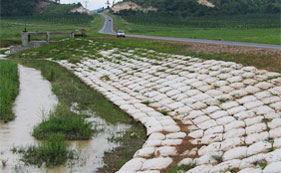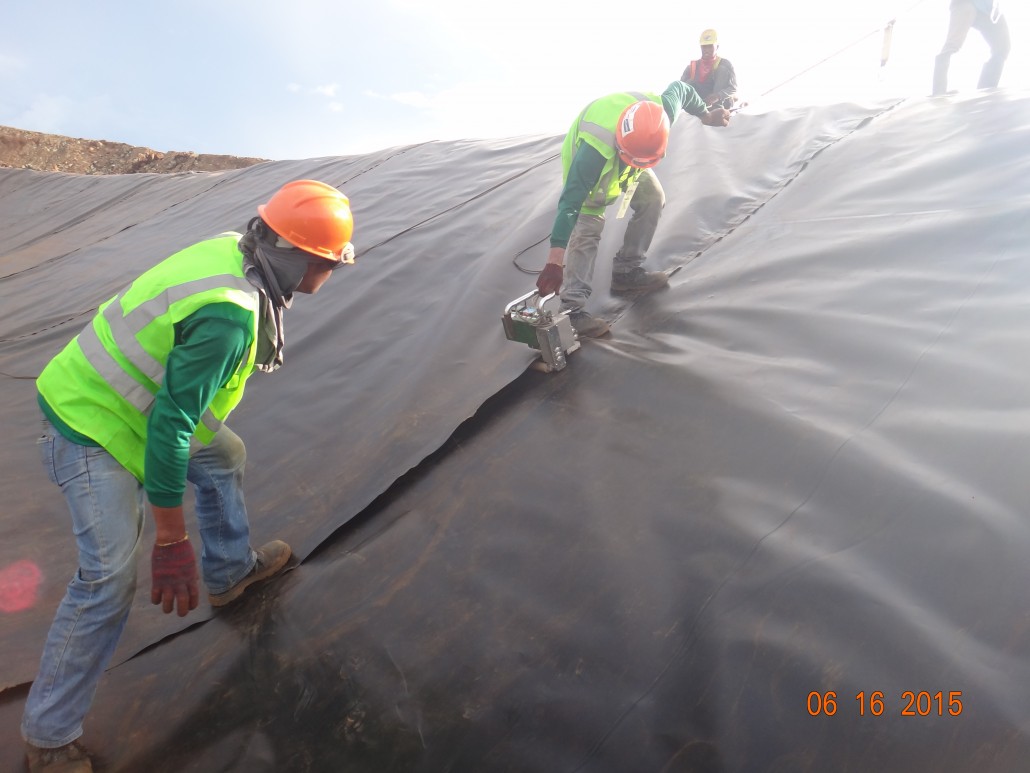
 Back to List
Back to List

1. Construction requirements for laying HDPE geomembrane
(1) Before laying the HDPE geomembrane, please supervise the engineer to fully confirm the site conditions to ensure that the foundation surface is flat, free of unevenness, and no sharp particles and hard debris that may damage the HDPE geomembrane. The materials (various performance indicators, whether there are bubbles, holes, wrinkles, damage, etc. on the surface) are sent to a third-party organization for strict inspection and qualified, and then laid after confirmation.
(2) Each roll of HDPE geomembrane should be numbered and placed in order. The geomembrane number should be submitted to the supervisory engineer for inspection.
(3) Geomembrane materials stored on site should not be exposed to the sun for a long time and should be kept away from fire sources.
(4) During the laying process, the staff shall not wear shoes that will damage the geomembrane, and must not smoke at the paving site to conduct other activities that may damage the geomembrane.
(5) The anti-fouling bag should be placed on the anti-fouling bag in time to prevent it from being scattered by the wind.
(6) Outdoor laying and welding of geomembrane should be carried out in the weather where the temperature is higher than 5°C and the wind is lower than 4, and there is no rain or snow.
(7) Vehicles are not allowed to pass directly through HDPE geomembrane and non-woven fabrics, nor are metal or sharp tools (such as shovel) used for HDPE geomembrane and non-woven fabrics.
(8) During the construction process, try to avoid shrinkage, wrinkling or material stress caused by temperature changes.
(9) During the welding process of HDPE geomembrane, the operating procedures, laying and welding quality of the supervising engineer should be checked in time, and any quality problems should be repaired in time.
(10) There should be no roots and obvious spikes in the anchoring trench of the geomembrane platform.
(11) Welding seam position and welding technical requirements
① When laying geomembrane on the soil slope, the lap joint should be parallel to the slope direction, and the position of the lateral lap weld of the slope should be more than 1.5m from the bottom edge of the slope.
② Minimize the corner joints and irregular geometric shapes.
③ Formal welding shall not be started before the samples welded by welding equipment have not passed the test welding inspection or have not been confirmed by the supervising engineer.
④ Before welding, the dust, dirt and other foreign objects on the surface of the geomembrane must be cleaned.
⑤ The overlapping part of two welded geomembranes shall not be less than 10㎝.
⑥ If the ambient temperature is lower than 5℃ or higher than 40℃, construction is not allowed.
⑦ Welding adopts double welding lap welding. Extrusion welding is only used for repairs (repair, covering), and welding equipment cannot be used.
⑧ The joint strength of welding should be higher than the strength of the base metal.
(12) There are sufficient welding equipment at the construction site to ensure continuous welding construction.
2. Climate requirements
(1) Considering the thermal expansion and contraction of the geomembrane, the temperature should be 5-40℃. According to experience, the geomembrane should be placed densely at low temperatures; it should be relaxed when the weather is hot; however, it should be noted that the high temperature at noon should be avoided in summer.
(2) Wind power and rainy days: construction should be stopped when wind power is more than 4 days or cloudy and rainy; when the wind is small, the geomembrane should be compressed with sandbags to facilitate construction.
3. Laying principles
(1) It should extend from the bottom to a higher position, do not pull it too tightly, and leave a margin of 1.50% to prepare for partial sinking and stretching.
(2) Two adjacent longitudinal seams should not be on the horizontal line and should be staggered by more than 1m.
(3) The longitudinal seam should be more than 1.5m away from the dam foot and the bending foot, and should be placed on a flat surface.
(4) Tilt first and then tilt.
(5) When laying a slope, the direction of the film should be basically parallel to the line of maximum slope.
4. Construction method:
After the foundation treatment of the heap leaching site, from bottom to top, the clay layer (water blocking layer) → HDPE geomembrane → compacted loess → HDPE geomembrane → compacted and screened fine soil → non-woven geotextile. During the laying process, the bricks, stones and other sharp objects that may pierce the geomembrane at the bottom of the pool should be further inspected and removed.
5. Construction technical requirements:
(1) Before laying, the installation unit must provide a layout drawing of the laying and welding plan, requiring a reasonable choice of laying direction, minimizing the joint stress, rationally arranging the position of each piece of material, and striving to minimize seams, with a slope greater than 10 There should be no horizontal joints within 10m of the slope toe;
(2) Before laying, the owner and the supervising engineer should jointly confirm under the on-site conditions to ensure that the foundation surface of the pool bottom is smooth, free of unevenness, sharp particles, and no hard debris that may damage the membrane. There must be no harmful debris at the depth of 25 ㎜ and the quality of impermeable materials (various performance indicators, whether there are bubbles, holes, wrinkles, damage, etc.) on the surface should be strictly inspected, and after it is confirmed Ready to be laid;
(3) The laying should be level and firm, reduce wrinkles, and should be ballasted and anchored in time after laying;
(4) Each geomembrane must be welded on the day of laying, and appropriate protective measures should be taken to prevent rainwater from entering the ground below;
(5) Welding requirements of geomembrane
① The welding method is generally double lap welding. Extrusion welding is only used for maintenance (repair, covering), and welding equipment cannot be used;
② There should be sufficient welding construction equipment at the construction site to ensure continuous welding construction;
③ The construction site should be equipped with a testing laboratory, equipped with necessary testing equipment, and conduct on-site testing of geomembrane welds through visual inspection, pressure testing, vacuum testing and destructive testing;
④ Formal welding shall not be started before the samples of welding equipment have not passed the test welding inspection or confirmed by the supervisory engineer;
⑤ If the ambient temperature is lower than 0°C or higher than 40°C, the construction unit shall provide a written certificate of welding quality equivalent to the specified temperature range and require the supervision engineer to confirm before proceeding.
⑥ Before welding, dust, dirt and other foreign objects on the surface of the geomembrane must be removed, and the welding edge must be cleaned;
⑦ Try to keep the vertical front end of the welder on the welding surface and maintain a certain pressure when welding;
⑧ Pay attention to the change of the lap width during the welding process at any time, so that the corresponding treatment can be carried out according to the actual situation. For double-pass welding, the overlap width of the weld is not less than 100mm. For extrusion welding, the overlap width of the weld is not less than 75mm, and the joint strength of the weld should not be less than the strength of the base metal.
Trusion Extrusion welding must first use hot air to bond the upper and lower geomembranes, and remove the oxide layer on the surface of the geomembrane with a sander at the welding position. The grinding width should be the same as the width of the extrusion welding;
⑩ After the geomembrane is welded, the weld should be sampled at the length of each weld for each weld of 150 meters and the strength of the welded joint should be tested;
⑪ For dual-track welding, the enclosed space formed by the geomembrane between the two welds should be air pressure leak detection test, and for extrusion welding, vacuum test or electric spark test should be used;